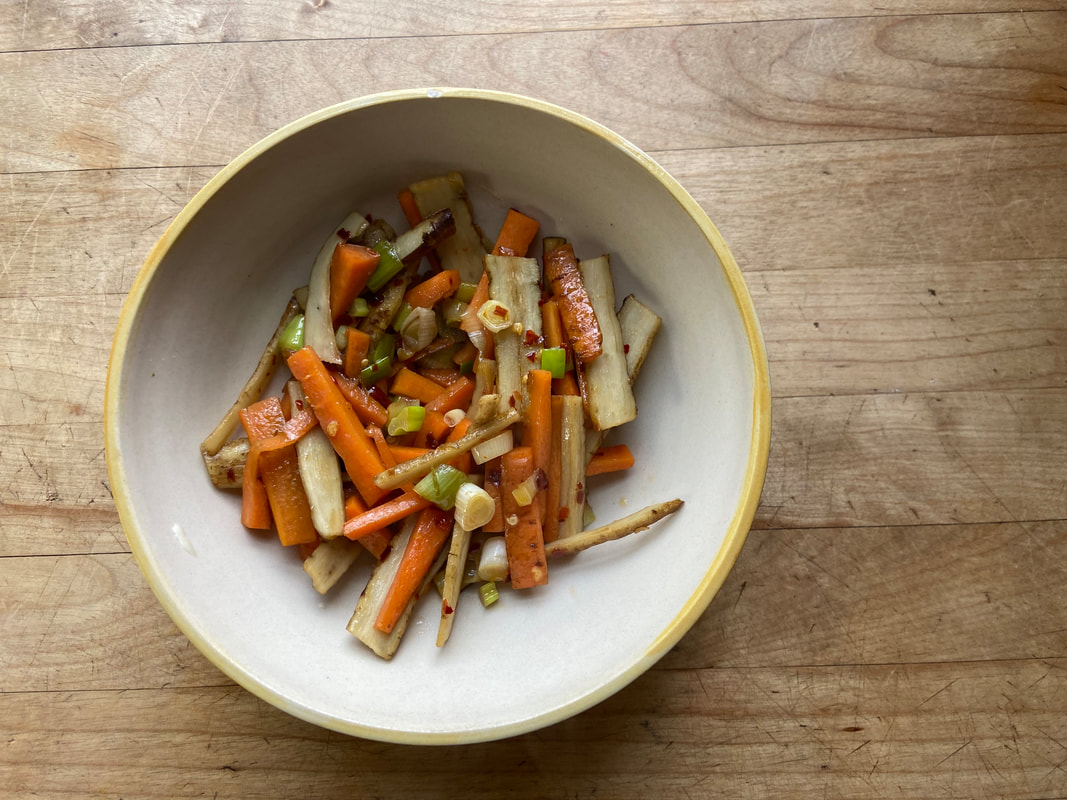From the kitchen of Jesse Haas, CNS, LN and adapted from one of her favorite cookbooks, Asparagus to Zucchini: A Guide to Cooking Farm-Fresh Seasonal Produce
Burdock root is an invasive “weed” brought to the U.S. by Chinese immigrants. It grows very well in the Midwest and can be harvested early in the spring before much else has had a chance to grow, making it one of the first locally grown produce items to hit the grocery stores.
Burdock isn't common on the Midwestern menu, which is really too bad, in my opinion! It's nutty flavor and crunchy texture makes it really fun to eat. You can add it to stir-fries, potroast and roast it in the oven with other root veggies. Pickled burdock is one of my favorite sushi ingredients.
Burdock has some special nutritional benefits, as well. It stimulates the production and secretion of bile from the gallbladder, thereby supporting digestive function and our body’s natural detoxification processes that are especially beneficial when added to a spring cleanse.
Burdock is also a source of fructooligosaccharides (aka FOS), a prebiotic compound that supports an ecosystem of beneficial bacteria in the colon. FOS has gotten a bad reputation by the low FODMAP diet, but is actually an incredibly beneficial compound for people who can digest it. FOS is also found in garlic, onions, asparagus, globe and Jerusalem artichokes, chicory and dandelion roots.
You’ll most likely find burdock at Asian groceries, though you may also find it in the spring at your local grocery co-op or farmers market. Kinpira gobo is a Japanese dish that I always look forward to eating in the spring. Serve as a side dish or add tofu or chicken and serve over rice for a complete meal.
Makes 4 side dish servings or 2 entrée servings
Download a printable recipe here.
Ingredients:
Method:
Burdock isn't common on the Midwestern menu, which is really too bad, in my opinion! It's nutty flavor and crunchy texture makes it really fun to eat. You can add it to stir-fries, potroast and roast it in the oven with other root veggies. Pickled burdock is one of my favorite sushi ingredients.
Burdock has some special nutritional benefits, as well. It stimulates the production and secretion of bile from the gallbladder, thereby supporting digestive function and our body’s natural detoxification processes that are especially beneficial when added to a spring cleanse.
Burdock is also a source of fructooligosaccharides (aka FOS), a prebiotic compound that supports an ecosystem of beneficial bacteria in the colon. FOS has gotten a bad reputation by the low FODMAP diet, but is actually an incredibly beneficial compound for people who can digest it. FOS is also found in garlic, onions, asparagus, globe and Jerusalem artichokes, chicory and dandelion roots.
You’ll most likely find burdock at Asian groceries, though you may also find it in the spring at your local grocery co-op or farmers market. Kinpira gobo is a Japanese dish that I always look forward to eating in the spring. Serve as a side dish or add tofu or chicken and serve over rice for a complete meal.
Makes 4 side dish servings or 2 entrée servings
Download a printable recipe here.
Ingredients:
- 2 medium burdock roots
- 2 medium carrots
- 4 scallions
- 1 Tbsp avocado or coconut oil
- 1 tsp rice wine or apple cider vinegar
- 1 Tbsp tamari or soy sauce
- 1/2 tsp honey
- ¼ tsp hot pepper flakes
- 1 Tbsp toasted sesame oil
- 2 tsp toasted sesame seeds (optional)
Method:
- Scrub burdock roots. Cut into 2-inch matchsticks; soak in cold water for 1 hour, changing the water once or twice.
- Scrub and cut carrot into matchsticks.
- Chop scallions.
- Mix vinegar, soy sauce, and honey in a small cup.
- Heat oil in wok or heavy skillet. Stir-fry vegetables 2-3 minutes until al dente.
- Sprinkle in pepper flakes; stir-fry 30 seconds.
- Add sauce; stir-fry 1 minute. Remove from heat; drizzle with toasted sesame oil and sprinkle toasted sesame seeds. Enjoy warm or room temperature.
| Jesse Haas, CNS, LN is a licensed functional nutritionist and certified health coach. She was a founding partner of Wellness Minneapolis and was an active practitioner with the clinic from 2014-2022. To connect with her regarding functional nutrition and health coaching services, please follow this link. |



 RSS Feed
RSS Feed